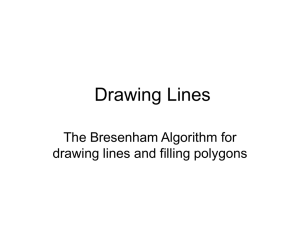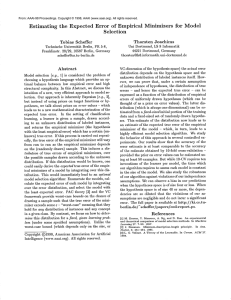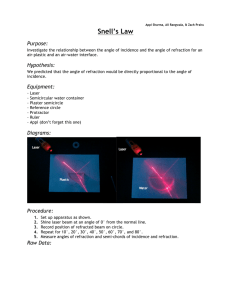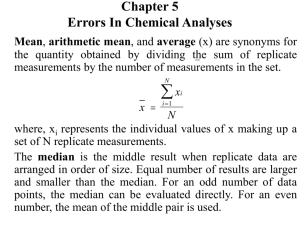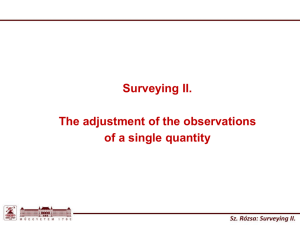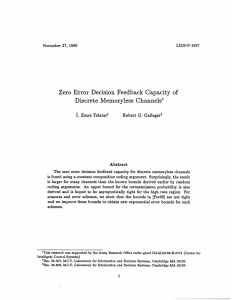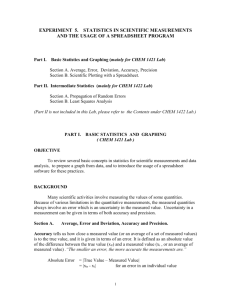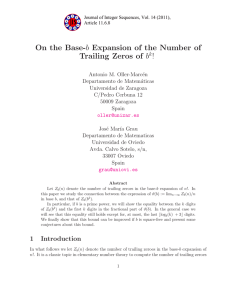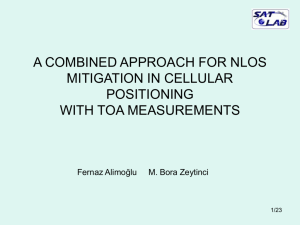chapter 1 : finite precision arithmetic number systems decimal
advertisement
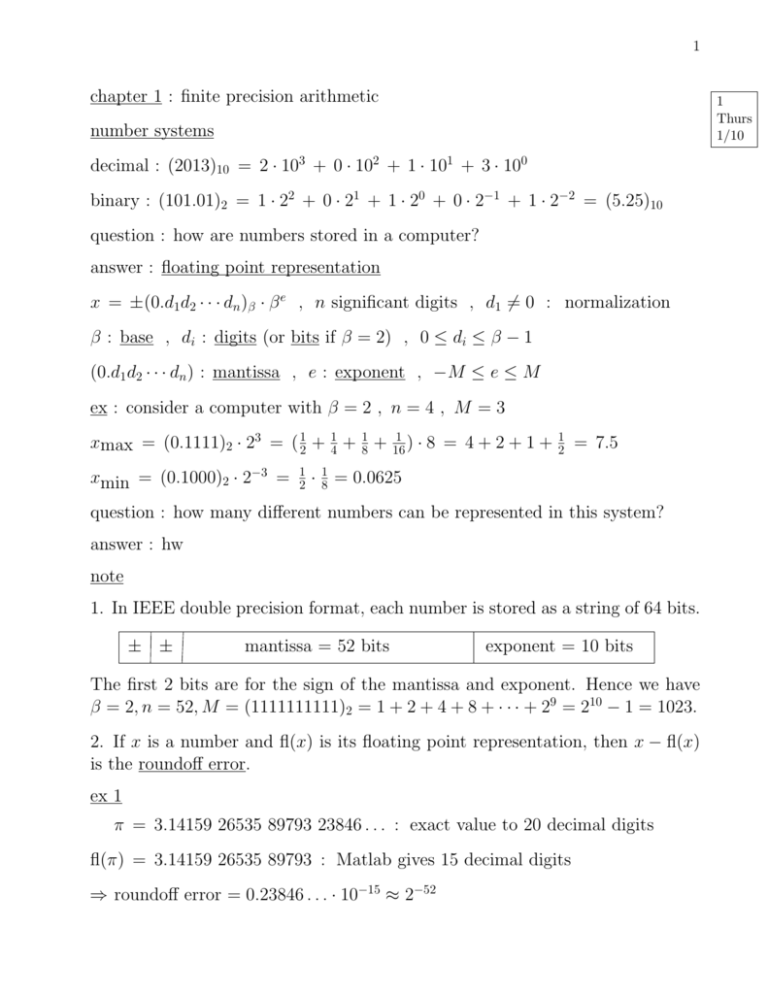
1
chapter 1 : finite precision arithmetic
1
Thurs
1/10
number systems
decimal : (2013)10 = 2 · 103 + 0 · 102 + 1 · 101 + 3 · 100
binary : (101.01)2 = 1 · 22 + 0 · 21 + 1 · 20 + 0 · 2−1 + 1 · 2−2 = (5.25)10
question : how are numbers stored in a computer?
answer : floating point representation
x = ±(0.d1 d2 · · · dn )β · β e , n significant digits , d1 6= 0 : normalization
β : base , di : digits (or bits if β = 2) , 0 ≤ di ≤ β − 1
(0.d1 d2 · · · dn ) : mantissa , e : exponent , −M ≤ e ≤ M
ex : consider a computer with β = 2 , n = 4 , M = 3
xmax = (0.1111)2 · 23 = ( 12 + 14 + 81 +
xmin = (0.1000)2 · 2−3 =
1
2
·
1
8
1
16 )
·8 = 4+2+1+
1
2
= 7.5
= 0.0625
question : how many different numbers can be represented in this system?
answer : hw
note
1. In IEEE double precision format, each number is stored as a string of 64 bits.
± ±
mantissa = 52 bits
exponent = 10 bits
The first 2 bits are for the sign of the mantissa and exponent. Hence we have
β = 2, n = 52, M = (1111111111)2 = 1 + 2 + 4 + 8 + · · · + 29 = 210 − 1 = 1023.
2. If x is a number and fl(x) is its floating point representation, then x − fl(x)
is the roundoff error.
ex 1
π = 3.14159 26535 89793 23846 . . . : exact value to 20 decimal digits
fl(π) = 3.14159 26535 89793 : Matlab gives 15 decimal digits
⇒ roundoff error = 0.23846 . . . · 10−15 ≈ 2−52
2
ex 2
0.1234 − 0.1233 = 0.0001 = (0.1000)10 · 10−3
⇒ the result has only 1 significant digit
Hence if 2 floating point numbers with n significant digits are subtracted, the
result may have less than n significant digits; this is called loss of significance
due to cancellation of digits.
ex 3 : quadratic formula
ax2 + bx + c = 0 ⇒ x =
−b ±
√
b2 − 4ac
2a
, pf : . . .
0.2x2 − 47.91x + 6 = 0 ⇒ x = 239.4247, 0.1253 : Matlab
Now use 4-digit arithmetic (i.e. each step is rounded to 4 digits, as if we’re using
a computer with n = 4).
q
√
√
47.91 ± 47.912 − 4(0.2)6 47.91 ± 2295 − 4.8 47.91 ± 2290
=
=
x=
2(0.2)
0.4
0.4
47.91 + 47.85 95.76
=
= 239.4 : all 4 digits are correct
47.91 ± 47.85
0.4
0.4
=
=
0.4
47.91 − 47.85 0.06
=
= 0.15 : only 1 digit is correct
0.4
0.4
question : what caused the problem?
answer : loss of significance in the subtraction 47.91 − 47.85
remedy 1 : Matlab (higher precision arithmetic)
remedy 2 : reformulate the arithmetic
√
√
b2 − (b2 − 4ac)
2c
−b − b2 − 4ac −b + b2 − 4ac
√
√
√
x=
·
=
=
2a
−b + b2 − 4ac 2a(−b + b2 − 4ac) −b + b2 − 4ac
=
2·6
12
=
= 0.1253 : now all 4 digits are correct
47.91 + 47.85 95.76
remedy 3 : solve for x using an iterative method (more later)
3
ex 4 : finite-difference approximation of a derivative
f
forward difference
f 0 (x) ≈
f (x + h) − f (x)
= D+ f (x)
h
question : how large is the error?
x
x+h
Taylor series : f (x) = f (a) + f 0 (a)(x − a) + 21 f 00 (a)(x − a)2 + · · ·
equivalent form :
x→x+h
a→x
)
⇒ f (x + h) = f (x) + f 0 (x)h + 21 f 00 (x)h2 + · · ·
⇒
f (x + h) − f (x)
= f 0 (x) + 12 f 00 (x)h + · · ·
h
|
{z
}
↑
↑
↑
approximation
exact
truncation error
value
Hence the error is proportional to h; we write this as D+ f (x) = f 0 (x) + O(h),
where the symbol O(h) means “order h”.
For example, if f (x) = ex , x = 1, then f 0 (1) = e = 2.71828 . . . is the exact value.
h
0.1
0.05
0.025
↓
0
D+ f (1)
2.8588
2.7874
2.7525
↓
e
|D+ f (1) − f 0 (1)|
0.1406
0.0691
0.0343
↓
0
|D+ f (1) − f 0 (1)|/h
1.4056
1.3821
1.3705
↓
e
1 00
2 = 2 f (1)
% Matlab
exact value = exp(1);
for j=1:65
h(j) = 1/2∧(j-1);
computed value = (exp(1+h(j)) - exp(1))/h(j);
error(j) = abs(computed value - exact value);
end
plot(h,error,h,error,’o’); xlabel(’h’); ylabel(’error’)
loglog(h,error,h,error,’o’); . . .
2
Tues
1/15
4
finite-difference approximation of a derivative
3
2.5
error
2
1.5
1
0.5
0
0
0.1
0.2
0.3
0.4
0.5
h
0.6
0.7
0.8
0.9
1
2
10
0
10
−2
error
10
−4
10
−6
10
−8
10
−10
10
−20
10
−15
10
−10
10
h
−5
10
0
10
5
note
If error ≈ chp , then p is called the order of accuracy of the approximation. In
this case we have log(error) ≈ log(chp ) = log c + p log h; this implies that the
slope of the data on the log-log plot gives the value of p. We see that p = 1 for
large h (expected) and p = −1 for small h (unexpected).
question : why does the error increase for small h?
1. The computed value has two sources of error: truncation error is due to replacing the exact derivative f 0 (x) by the finite-difference approximation D+ f (x),
and roundoff error is due to using finite precision arithmetic.
2. The truncation error is O(h) and the roundoff error is O(/h), where ≈ 10−15
in Matlab.
3. The total error is O(h) + O(/h). Hence, for large h the truncation error
dominates the roundoff error, but for small h the roundoff error dominates the
truncation error.
note
backward difference : D− f (x) =
centered difference : D0 f (x) =
f (x) − f (x − h)
h
f (x + h) − f (x − h)
. . . hw
2h
